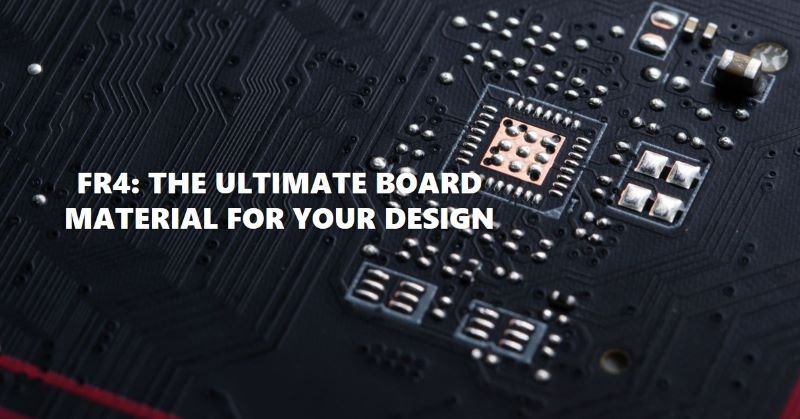Is FR4 the Best Board Material for Your Design?
The history of FR4 dates back to the mid-20th century when advancements in material science led to the development of more durable and efficient substrates for electronic components. Over the years, FR4 has become the standard for PCB manufacturing, largely due to its cost-effectiveness, ease of manufacturing, and superior performance characteristics. Its electrical insulation properties, low water absorption, and stability under varying environmental conditions make it the preferred choice for most electronic circuits.. In this article, we will delve into the properties and advantages of FR4 substrate, its application in PCBs, its limitations, and tips for choosing the right FR4 material.
What is FR4 Substrate Material?
FR4 is a widely utilized substrate material in the electronics industry, known for its robustness and versatility. The term “FR4” refers to a specific grade of glass-reinforced epoxy laminate used in the manufacturing of printed circuit boards (PCBs). The “FR” in FR4 stands for “flame retardant,” and the “4” denotes a grade within the NEMA (National Electrical Manufacturers Association) standard for glass-reinforced materials.
The composition of FR4 material includes a woven fiberglass cloth and an epoxy resin binder. This combination results in a composite material that is not only mechanically strong but also flame resistant. The fiberglass cloth provides structural integrity, while the epoxy resin offers excellent adhesion and chemical resistance. One of the notable features of FR4 is its adherence to the UL94V-0 standard, which signifies that the material will stop burning within 10 seconds after the ignition source is removed, making it a reliable choice for electronic applications.
Properties of FR4 Substrate
The unique properties of FR4 substrate make it exceptionally useful in PCB manufacturing:
- Good Dielectric Properties: High resistance to electrical current flow minimizes signal loss and interference between circuit pathways.
- Temperature Resistance: Withstanding temperatures up to 130-140 degrees Celsius, FR4 substrates are suitable for devices operating at elevated temperatures.
- Chemical Resistance: FR4 exhibits good resistance to various chemicals, including acids encountered during manufacturing processes, preventing damage during operations.
- Flame Retardancy: FR4 substrates resist ignition and do not contribute to the spread of fire, enhancing safety in electronic devices.
- Mechanical Strength: The fiberglass component provides mechanical strength and dimensional stability, preventing bending during PCB assembly.
- Electrical Insulation: Excellent electrical insulation makes FR4 ideal for devices requiring separation between conductive elements.
- Machinability: FR4 can be easily drilled, machined, and etched, allowing for complex PCB designs.
- Compatibility: Compatible with common PCB manufacturing processes such as drilling, soldering, and plating.
- Dimensional Stability: Maintains shape under extreme conditions like high humidity and varying temperatures, ensuring reliability.
- Availability: Widely available and easily sourced online from trusted suppliers like JLCPCB.
- Thermal Conductivity: Dissipates heat effectively from electrical components.
- Environmentally Friendly: Considered environmentally friendly due to its flame retardancy and durability.
How Is FR4 Used in PCBs?
The use of FR4 in PCBs involves several steps:
- Designing Procedure: Using specialized software to design the PCB circuit pattern.
- Preparation of Materials: Selecting FR4 sheets based on desired thickness and specifications.
- Substrate Preparation: Treating and cleaning FR4 sheets to improve adherence and quality.
- Copper Addition: Adding copper to create conductive pathways for power distribution and signal transmission.
- Design Transfer: Using ultraviolet light in a photographic process to transfer the PCB design onto the FR4 sheet.
- Etching: Removing unwanted copper while keeping the desired copper intact.
- Machining: Drilling holes and plating them with copper for electrical conductivity and soldering.
- Surface Finish: Treating the PCB with a surface finish to aid soldering and prevent oxidation.
- Adding Markings: Printing important markings, commonly known as silkscreen, on the PCB.
- Testing: Conducting various tests to ensure smooth operation, quality, and functionality.
When Is FR4 Not the Best Material for Your Board?
Despite its many advantages, FR4 may not be suitable in certain situations:
- Harsh Environments: When exposed to extreme chemicals or temperatures beyond its capabilities, FR4 may not perform well.
- High Frequencies: For devices requiring very high-speed signals or microwave frequencies, ceramic-based substrates might be more appropriate.
- High Temperatures: FR4’s limited temperature resistance makes it unsuitable for extremely hot environments.
- Thinner Designs: For very thin or small designs, alternatives like flex PCBs might be better.
Tips for Selecting the Right FR4 Material
Consider these tips when selecting FR4 material:
- Thickness: Choose thicker sheets for more mechanical strength or thinner sheets for a compact design.
- Glass Transition Temperature: Ensure the substrate has a high enough glass transition temperature to avoid performance issues.
- Copper Weight: Balance between heavier copper for better conductivity and lighter copper for cost-effectiveness.
- Flame Retardancy: Ensure compliance with industry safety standards.
- Cost Consideration: Select based on the required specifications and budget.
- Supplier Support: Maintain direct contact with your supplier for compatibility advice and support.
Conclusion
In conclusion, FR4 substrate is an excellent choice for PCB designs, offering reliable performance and cost-effectiveness. Its properties like good dielectric and chemical resistance, flame retardancy, mechanical strength, and dimensional stability make it indispensable in the industry. However, it is important to consider its limitations in chemically harsh environments, high temperatures, and thin designs. By following the tips for selecting the right FR4 material, you can optimize your PCB manufacturing process and achieve high-quality results.








